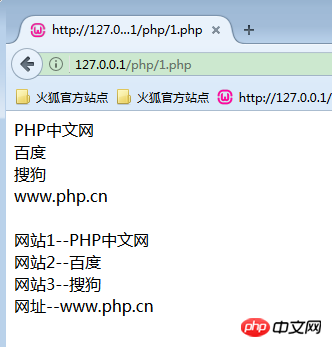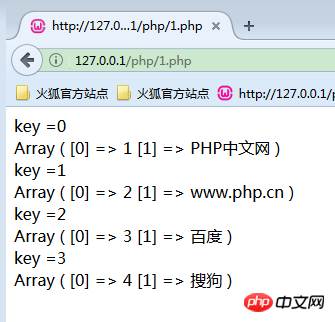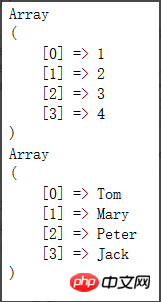 Backend Development
Backend Development
 PHP Tutorial
PHP Tutorial
 Detailed explanation of usage examples of foreach array traversal in PHP array (picture)
Detailed explanation of usage examples of foreach array traversal in PHP array (picture)
Detailed explanation of usage examples of foreach array traversal in PHP array (picture)
What is foreach to traverse an array?
When we use foreach to traverse an array, we often make mistakes due to unclear concepts. Here is a brief introduction to commonly used foreach operations.
(PHP 4, PHP 5, PHP 7)
The foreach syntax structure provides a simple way to traverse an array. foreach can only be applied to arrays and objects. If you try to apply it to variables of other data types, or uninitialized variables, an error message will be issued.
Two syntaxes for each foreach to traverse an array:
foreach (array_expression as $value)
statement
foreach (array_expression as $key => $value)
statementThe first format traverses the given array_expression array. In each loop, the value of the current unit is assigned to $value and the pointer inside the array moves forward one step (so the next unit will be obtained in the next loop).
The second format does the same thing, except that the key name of the current unit will also be assigned to the variable $key in each loop.
Since PHP 5, it is also possible to traverse objects.
Note: When foreach starts executing, the pointer inside the array will automatically point to the first unit. This means there is no need to call reset() before the foreach loop.
Note: Unless the array is referenced, foreach operates on a copy of the specified array, not the array itself. foreach has some side effects on array pointers. Do not rely on the value of an array pointer during or after a foreach loop unless it is reset.
Since PHP 5, it is easy to modify the elements of an array by adding & before $value. This method assigns by reference rather than copying a value. The reference to
<?php
header("Content-Type:text/html; charset=utf-8");
$arr = array(1, 2, 3, 4);
foreach ($arr as &$value) {
$value = $value * 2;
}
// $arr is now array(2, 4, 6, 8)
unset($value); // 最后取消掉引用
?>$value is only available if the array being traversed can be referenced (for example, it is a variable). The following code will not run:
<?php
foreach (array(1, 2, 3, 4) as &$value) {
$value = $value * 2;
}
?>Note: The $value reference of the last element of the array will still be retained after the foreach loop. It is recommended to use unset() to destroy it. foreach does not support the ability to suppress error messages using "@".
The following is an example of php foreach traversing an array
1. The array to be traversed is a one-dimensional array, which is relatively simple. If it is a single array, it is expressed in two ways, as follows:
<?php
header("Content-Type:text/html; charset=utf-8");
$array = array("PHP中文网","百度","搜狗","www.php.cn");
foreach ($array as $value){
echo $value."<br>";
}
echo "<br>";
foreach ($array as $key =>$value){
echo $key."--".$value."<br>";
}
?>The output result is:

2. If it is a one-dimensional associative array, it is displayed as follows, Note that the key values are different:
<?php
header("Content-Type:text/html; charset=utf-8");
$array = array("网站1"=>"PHP中文网","网站2"=>"百度","网站3"=>"搜狗","网址"=>"www.php.cn");
foreach ($array as $value){
echo $value."<br>";
}
echo "<br>";
foreach ($array as $key =>$value){
echo $key."--".$value."<br>";
}
?>The traversal result is:

3. It is a little troublesome when traversing a two-dimensional array One point, the value at this time is an array, from which a variety of methods of operating arrays can be derived. Let’s traverse the basic two-dimensional array first:
<?php
header("Content-Type:text/html; charset=utf-8");
$array = array(
array("1","PHP中文网"),
array("2","www.php.cn"),
array("3","百度"),
array("4","搜狗")
);
foreach ($array as $value){
print_r($value);
echo "<br>";
}
?>The traversal results are as follows:

Use the second method. When traversing the array, pay attention to the key The value of , do not confuse it with the array id value;
<?php
header("Content-Type:text/html; charset=utf-8");
$array = array(
array("1","PHP中文网"),
array("2","www.php.cn"),
array("3","百度"),
array("4","搜狗")
);
foreach ($array as $key =>$value){
echo "key =".$key."<br>";
print_r($value);
echo "<br>";
}
?>The traversal results are as follows:

In addition, there are often requests to change a certain column of the two-dimensional array It becomes a one-dimensional array. At this time, the corresponding fields in value need to be taken out and placed in a one-dimensional array. If it is operated with a for loop, it is more cumbersome. It is simpler to use foreach. As follows, get the id column and name column of the current array. , stored in one-dimensional arrays respectively:
<?php
header("Content-Type:text/html; charset=utf-8");
$array = array(
array("id"=>"1","name"=>"PHP中文网"),
array("id"=>"2","name"=>"www.php.cn"),
array("id"=>"3","name"=>"百度"),
array("id"=>"4","name"=>"搜狗")
); //二维数组定义
//获取某一列作为一维数组
$idArr = array();//id列
$nameARR = array();//name列
foreach($array as $key => $value){
$arr = $value["id"];
$idArr =$arr; //存入ID列
$name = $value["name"];
$nameARR = $name; //存入name列
print_r($idArr);
print_r($nameARR);
}
?>The traversal result is:

[Related tutorial recommendations]
1. Recommended related topics: "php array (Array)"
2. Recommended related video courses: " Use a foreach loop to traverse: index and associative array》
The above is the detailed content of Detailed explanation of usage examples of foreach array traversal in PHP array (picture). For more information, please follow other related articles on the PHP Chinese website!

Hot AI Tools

Undresser.AI Undress
AI-powered app for creating realistic nude photos

AI Clothes Remover
Online AI tool for removing clothes from photos.

Undress AI Tool
Undress images for free

Clothoff.io
AI clothes remover

Video Face Swap
Swap faces in any video effortlessly with our completely free AI face swap tool!

Hot Article

Hot Tools

Notepad++7.3.1
Easy-to-use and free code editor

SublimeText3 Chinese version
Chinese version, very easy to use

Zend Studio 13.0.1
Powerful PHP integrated development environment

Dreamweaver CS6
Visual web development tools

SublimeText3 Mac version
God-level code editing software (SublimeText3)

Hot Topics
 1667
1667
 14
14
 1426
1426
 52
52
 1328
1328
 25
25
 1273
1273
 29
29
 1255
1255
 24
24
 PHP: A Key Language for Web Development
Apr 13, 2025 am 12:08 AM
PHP: A Key Language for Web Development
Apr 13, 2025 am 12:08 AM
PHP is a scripting language widely used on the server side, especially suitable for web development. 1.PHP can embed HTML, process HTTP requests and responses, and supports a variety of databases. 2.PHP is used to generate dynamic web content, process form data, access databases, etc., with strong community support and open source resources. 3. PHP is an interpreted language, and the execution process includes lexical analysis, grammatical analysis, compilation and execution. 4.PHP can be combined with MySQL for advanced applications such as user registration systems. 5. When debugging PHP, you can use functions such as error_reporting() and var_dump(). 6. Optimize PHP code to use caching mechanisms, optimize database queries and use built-in functions. 7
 PHP and Python: Comparing Two Popular Programming Languages
Apr 14, 2025 am 12:13 AM
PHP and Python: Comparing Two Popular Programming Languages
Apr 14, 2025 am 12:13 AM
PHP and Python each have their own advantages, and choose according to project requirements. 1.PHP is suitable for web development, especially for rapid development and maintenance of websites. 2. Python is suitable for data science, machine learning and artificial intelligence, with concise syntax and suitable for beginners.
 PHP vs. Python: Understanding the Differences
Apr 11, 2025 am 12:15 AM
PHP vs. Python: Understanding the Differences
Apr 11, 2025 am 12:15 AM
PHP and Python each have their own advantages, and the choice should be based on project requirements. 1.PHP is suitable for web development, with simple syntax and high execution efficiency. 2. Python is suitable for data science and machine learning, with concise syntax and rich libraries.
 PHP in Action: Real-World Examples and Applications
Apr 14, 2025 am 12:19 AM
PHP in Action: Real-World Examples and Applications
Apr 14, 2025 am 12:19 AM
PHP is widely used in e-commerce, content management systems and API development. 1) E-commerce: used for shopping cart function and payment processing. 2) Content management system: used for dynamic content generation and user management. 3) API development: used for RESTful API development and API security. Through performance optimization and best practices, the efficiency and maintainability of PHP applications are improved.
 The Enduring Relevance of PHP: Is It Still Alive?
Apr 14, 2025 am 12:12 AM
The Enduring Relevance of PHP: Is It Still Alive?
Apr 14, 2025 am 12:12 AM
PHP is still dynamic and still occupies an important position in the field of modern programming. 1) PHP's simplicity and powerful community support make it widely used in web development; 2) Its flexibility and stability make it outstanding in handling web forms, database operations and file processing; 3) PHP is constantly evolving and optimizing, suitable for beginners and experienced developers.
 PHP vs. Other Languages: A Comparison
Apr 13, 2025 am 12:19 AM
PHP vs. Other Languages: A Comparison
Apr 13, 2025 am 12:19 AM
PHP is suitable for web development, especially in rapid development and processing dynamic content, but is not good at data science and enterprise-level applications. Compared with Python, PHP has more advantages in web development, but is not as good as Python in the field of data science; compared with Java, PHP performs worse in enterprise-level applications, but is more flexible in web development; compared with JavaScript, PHP is more concise in back-end development, but is not as good as JavaScript in front-end development.
 PHP and Python: Different Paradigms Explained
Apr 18, 2025 am 12:26 AM
PHP and Python: Different Paradigms Explained
Apr 18, 2025 am 12:26 AM
PHP is mainly procedural programming, but also supports object-oriented programming (OOP); Python supports a variety of paradigms, including OOP, functional and procedural programming. PHP is suitable for web development, and Python is suitable for a variety of applications such as data analysis and machine learning.
 PHP and Python: Code Examples and Comparison
Apr 15, 2025 am 12:07 AM
PHP and Python: Code Examples and Comparison
Apr 15, 2025 am 12:07 AM
PHP and Python have their own advantages and disadvantages, and the choice depends on project needs and personal preferences. 1.PHP is suitable for rapid development and maintenance of large-scale web applications. 2. Python dominates the field of data science and machine learning.



